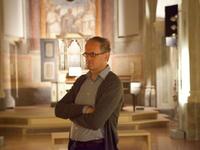
Liuwe Tamminga, organ
Bruce Dickey, cornetto
Music of Guami, Trabaci, Palestrina, Gabrielle, de Murcia
Liuwe Tamminga is considered one of the major specialists of sixteenth and seventeenth century Italian repertoires for organ. He is the organist of the historic organs at the Basilica of San Petronio in Bologna together with Luigi Ferdinando Tagliavini, where he plays the magnificent instruments by Lorenzo da Prato (1471-75) and Baldassarre Malamini (1596).
He has recorded several compact discs, among them: the complete works of Marc’Antonio Cavazzoni (awarded the “Diapason d’Or”, Preis der Deutschen Schallplattenkritik 2005, Goldberg 5 stars); the complete Fantasies of Frescobaldi (best recording of Amadeus, March 2006 and Diapason 5 stars), complete Ricercars (“Diapason d’Or”) and complete Capricci; “Mozart in Italia” (Preis der Deutschen Schallplattenkritik 2006 and Diapason 5 stars); and a recording dedicated to Andrea and Giovanni Gabrieli, together with L. F. Tagliavini (“Choc de la musique” and the International Prize “Antonio Vivaldi” of the Cini Foundation in Venice, 1991) and since 2008 recordings of Fiorenzo Maschera, “the historic organs of the Canary Islands” , “Il ballo di Mantova”, Giacomo Puccin (“Diapason d’Or”), Giuseppe Verdi, Giovanni Gabrieli (“Diapason d’Or”) and La Tarantella.
Tamminga has also edited keyboard music by Giovanni de Macque, Giulio Segni, Palestrina, Jacques Buus, Marc’Antonio Cavazzoni and music for two organs.
Since 2010 he is the curator of the San Colombano-Tagliavini collection of early music instruments in Bologna. He performs all over Europe, in the U.S.A, and in Japan.
Bruce Dickey is one of a handful of musicians worldwide who have dedicated themselves to reviving the cornetto - once an instrument of great virtuosi, but which lamentably fell into disuse in the 19th century. The revival began in the 1950s, but it was largely Bruce Dickey, who, from the late 1970s, created a new renaissance of the instrument, allowing the agility and expressive power of the cornetto to be heard once again. His many students, over more than 30 years of teaching at the Schola Cantorum Basiliensis, have helped to consolidate and elevate the status of this once forgotten instrument. For his achievements the Historic Brass Society awarded him in 2000 the prestigious Christopher Monk Award for “his monumental work in cornetto performance, historical performance practice and musicological scholarship.” In 2007 he was honored by British conductor and musicologist Andrew Parrott with a “Taverner Award” as one of 14 musicians whose “significant contributions to musical understanding have been motivated by neither commerce nor ego.”
In the course of his long career as a performer and recording artist he has worked with most of the leading figures in the field of early music, including the legendary pioneers of historically informed perfomance, Gustav Leonhardt, Frans Brüggen and Nikolaus Harnoncourt. He was a member for over ten years of Jordi Savall’s Hesperion XX , and has frequently and repeatedly collaborated wth Ton Koopman, Monica Huggett, Philippe Herreweghe and many others. Of special importance has been his long-time friendship and collaboration with Andrew Parrott, and in more recent years with Konrad Junghänel.
Bruce Dickey can be heard on countless recordings. His solo CD (“Quel lascivissimo cornetto…”) on Accent with the ensemble Tragicomedia was awarded the Diapason d’or. His second solo CD, entitled “La Bella Minuta”, has just been released on the Passacaille label.
In addition to performing, Bruce Dickey is much in demand as a teacher, both of the cornetto and of seventeenth-century performance practice. In addition to his regular class at the Schola Cantorum he has taught at the Royal Conservatory in The Hague, the Accademia Chigiana in Siena, and the Early Music Institute at Indiana University, as well as master classes in the United States, Canada, Europe and Japan. He is also active in research on performance practice, and has published, together with Michael Collver, a catalog of the surviving cornetto repertoire, and, together with trumpeter Edward Tarr, a book on historical wind articulation. In 1997, together with his wife Candace Smith, he founded Artemisia Editions, a small publishing house which produces editions of music from17th-century Italian convents.